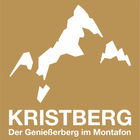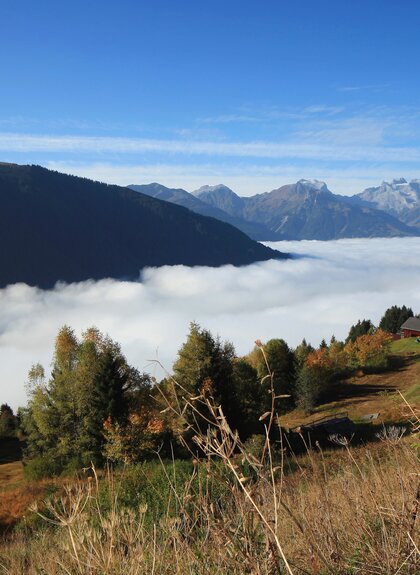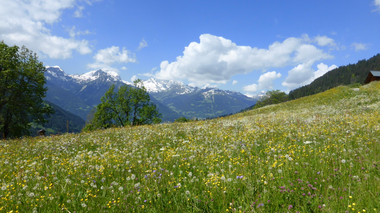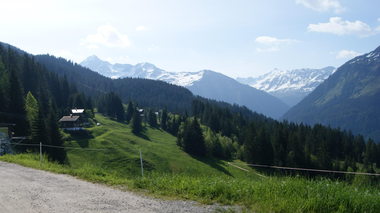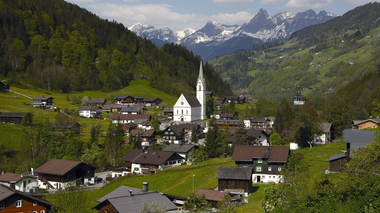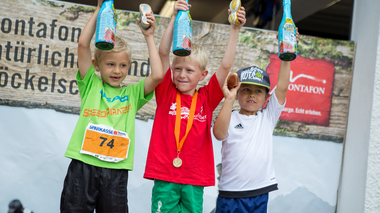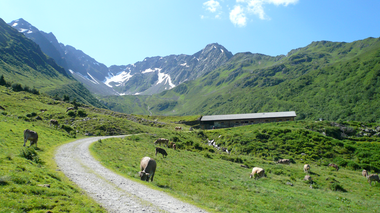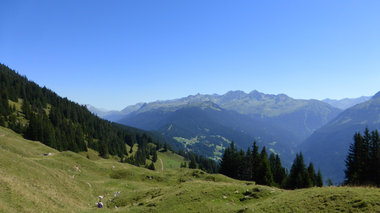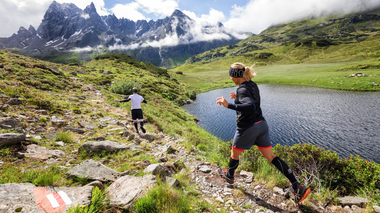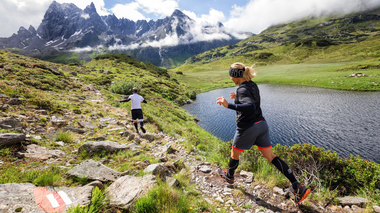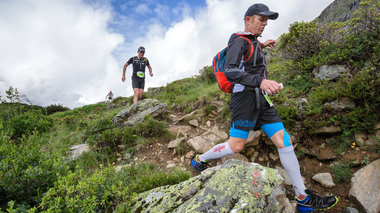Your running routes on the Kristberg and in the Silbertal
There are 9 different running and training routes on the Kristberg and in Silbertal. The starting points are on the Kristberg at the mountain station and in Silbertal at the soccer pitch.
Whether you are a pleasure runner who simply wants to run a little, or you are looking for a real physical and mental challenge, the 9 different running and training routes are sure to have the right thing for you.
The running and training routes are also ideal for Nordic walking.
The running, Nordic walking & training information
... are available as PDF files and on site as flyers for you
As can be seen from the AMAS 2000 altitude study, running and training at an altitude of approx. 1,500 meters is ideal for the body.
AMAS 2000 height study
The Austrian high-altitude study "AMAS 2000" proves it: Mountain vacation brings health effects
The economization of cardiovascular behavior, improvement of blood sugar and blood lipid metabolism, positive neuro-psychological effects and much more.
Treat yourself to a mountain vacation - your body will thank you!
With the AMAS 2000 (Austrian Moderate Altitude Study) medical study, the first of its kind in the world, the first extensive scientific evidence of the health benefits of a mountain vacation was provided in autumn 1998.
Numerous statistical results of the pilot project are already available, and the trends clearly indicate the positive effect of a vacation at moderate altitudes on blood count, oxygen transport, blood sugar and blood fat metabolism, blood pressure and pulse rate, weight and mental health.
Interaction between medical science and tourism
Every year, 60 million people are drawn to the high altitudes of the Alps, where they find well-being and relaxation. 80% of Austria's summer guests come to the Alpine republic to hike, according to GBÖ 1998 (Guest Survey Austria), 51% even hike frequently.
Until now there has been no comprehensive answer to the question of the causes of the recreational effects of mountain vacations. AMAS 2000 now provides the scientific justification for the usefulness of mountain vacations on the one hand, and on the other, Austria is challenged in its competence for vacation medicine.
The scientific director of the study and the research team, Vorarlberg University Professor Dr. Egon Humpeler, on the cooperation between medicine and tourism: "It is a great achievement of tourism to say yes to research and thus enable an important area of medical vacation research in the service of people in the leisure society". This commitment undoubtedly has a positive effect on tourism, as it provides it with scientifically sound arguments for healthy mountain vacations.
The name AMAS 2000 refers to the sea level of 2000 m, up to which the studies are carried out, and the year of completion 2000. AMAS 2000 is financed by the Ministry of Economics, the Austrian National Tourist Office, the regional tourism organizations of Carinthia, Salzburg, Tyrol and Vorarlberg as well as the municipalities in which the studies are carried out. It is not a commissioned study, but an academic study in which all scientists waive their fees.
Up to 200 parameters measured
After approval of the protocol by the ethics committee of the University of Innsbruck, the project started in autumn 1998. 22 male subjects (for statistical reasons, only male subjects were selected for this first part of the study) aged between 39 and 65 (average age 55) who suffer from civilization-related health problems ("metabolic syndrome") such as obesity, high blood pressure, high levels of sugar and fat in the blood, etc. took part in the three-week pilot study. They were selected by the Medical Clinic of the University of Innsbruck in the Tyrol region and completed a standard mountain vacation with hikes between 1,400 and 2,000 meters above sea level, walks, light sport and a normal diet. Up to 200 parameters per subject and day were measured before, during and after the high-altitude stay. The evaluation was carried out according to strict scientific biostatic criteria.
According to Prof. Dr. Humpeler, the most striking results are partly statistically confirmed and partly proven as clear trends:
The economization of cardiovascular behavior, especially in blood pressure and pulse behavior (in some test subjects, blood pressure-lowering medication could be reduced and even discontinued)
Improvement of the blood sugar and blood lipid metabolism situation
Interesting change in anthropometric data: There was an average weight loss of 2 kg (with a normal diet), whereby the decrease was mainly due to a decrease in body fat mass, body water and fat-free body mass remained unchanged.
Positive neuro-psychological effects: significant and lasting reduction in subjective complaints, improvement in positive attitude towards life, negative mood decreases, average reaction times are persistently improved, sleep quality and duration as well as the ability to sleep through the night have increased significantly.
Increase in young red blood cells, which have better oxygen transport capabilities, decrease in substances that promote thrombosis (fibrinogen).
Summary: magic word "mild hypoxia"
According to the trends of the study, the secret of the recreational value of a mountain vacation lies in the mobilization and economization of energy by the human organism. The body registers the low partial pressure of oxygen ("mild hypoxia") at altitudes between 1,400 and 2,000 m and gives a powerful boost to its activities.
This is followed by a throttling of these stronger activities and thus an economization. Professor Humpeler compares the process to an engine. "At first it revs up to achieve full power, but then at the end of a stay at altitude it runs more smoothly, at a lower speed, but delivers the same or even better performance".
The body already reacts at the stimulus altitude of 1,400 to 2,000 m, although it would have sufficient oxygen. More young red blood cells are formed without their total number increasing, so the blood retains its normal consistency. However, the oxygen transport to the cells improves significantly.
This "fountain of youth effect" is purely altitude-related. The altitude mobilizes physical reserves and simply being at altitude has a training effect. This mobilization of physical activity is an additional bonus that makes up the physiological recovery value. The duration of a vacation to benefit from these health effects is at least three weeks.
Added to this is the overall experience of a stay and exercise in the flora and fauna of the mountains. Humpeler: "There are three important elements to a vacation: relaxation, fitness/wellness and adventure. They are included in a mountain and hiking vacation".
This study is also very important because its results are an essential prerequisite for further studies. It will be followed in the year 2000 by the comparative studies in valley and high altitude areas necessary to complete the scientific findings.
Facts - AMAS 2000 (Austrian Moderate Altitude Study), 1998 – 2000
"Influence of medium altitude on patients with metabolic syndrome"
Patronage: University of Innsbruck and Austrian Society for Alpine and High Altitude Medicine.
Performers: Univ.-Prof. Dr. Egon Humpeler, Bregenz (overall director), Univ.-Doz. Dr. Wolfgang Schobersberger (Innsbruck University Hospital, project manager)
Scientific Advisory Board: A. Univ.-Prof. Dr. Monika Lechleitner, A. Univ.-Prof. Dr. Fritz Hoppichler (both University Hospital Innsbruck), Ass.-Prof. Dr. Holger Baumgartner (Institute for Biochemical Pharmacology Innsbruck), Univ.-Prof. Dr. Peter Schmid (Bad Schallerbach), Prim. Doz. Dr. H. Hörtnagel (Institute for Sports and Circulatory Medicine, Innsbruck), PD Dr. Hanns-Christian Gunga (Institute for Physiology, Berlin), Dr. Anton Klingler (Laboratory for Theoretical Surgery, Innsbruck)
Secretariat: Dr. Gebhard Riedmann, Bregenz
Funding: Ministry of Economic Affairs, Austrian National Tourist Office, regional tourism organizations Carinthia, Salzburger Land, Tyrol, Vorarlberg, pilot municipalities
